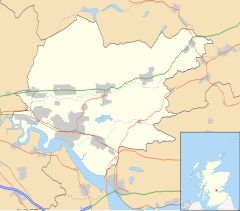Alva, Clackmannanshire
Alva
|
|
|---|---|
| Alva shown within Clackmannanshire | |
| Area | 0.598 sq mi (1.55 km2) |
| Population |
5,181 (2001 census) |
| • Density | 8,664/sq mi (3,345/km2) |
| OS grid reference | NS882970 |
| Council area | |
| Lieutenancy area | |
| Country | Scotland |
| Sovereign state | United Kingdom |
| Post town | ALVA |
| Postcode district | FK12 |
| Dialling code | 01259 |
| Police | Scottish |
| Fire | Scottish |
| Ambulance | Scottish |
| EU Parliament | Scotland |
| UK Parliament | |
| Scottish Parliament | |
5,181 (2001 census)
Alva (Scottish Gaelic: Allamhagh Beag, meaning little plain of the rock) is a small town in Clackmannanshire, set in the Central Lowlands of Scotland. It is one of a number of towns situated immediately to the south of the Ochil Hills, collectively referred to as the Hillfoots Villages or simply The Hillfoots. It is located between Tillicoultry and Menstrie. Alva had a resident population of 5,181 at the 2001 census but has since been revised to 4,960 in 2006. Alva is noted for being in Clackmannanshire, the smallest county in Scotland with the longest name, also knows as 'The Wee County'.
During the Industrial Revolution, Alva developed as a textile manufacturing centre; the woollen mills, originally water-powered, provided employment for locals and migrants to the area. The Mill Trail Centre is next to the Cochrane Park, housed in the old Glentana Mill built in 1887. It houses permanent exhibitions about the history of the old woollen industry and the experiences of the many people employed in the industry. The Dalmore Works was built in 1874 for Wilson Brothers, who produced textile products including tweed, woollen novelty fabrics and mohair and woollen rugs. The works were operated by Wilsons until 1964, when the failure of Wilson Bros (Alva) Ltd, set up jointly with McBean and Bishop Ltd, caused the firm to lose the works.
Alva was historically in an exclave of Stirlingshire, but it was transferred to Clackmannanshire in 1891.
Alva lies right at the foot of the Ochil Hills. The Ochil Fault, movement of which gave rise to the steep southern scarp of the Ochils, coincides approximately with the old road along the base of the hills. The rock beneath the carse in this area is carboniferous.
...
Wikipedia

